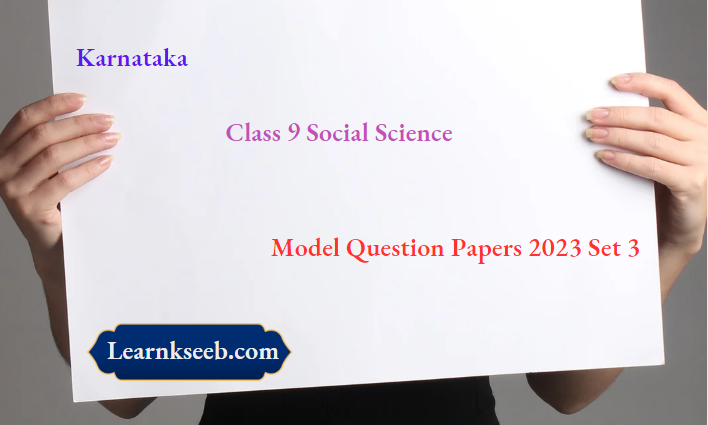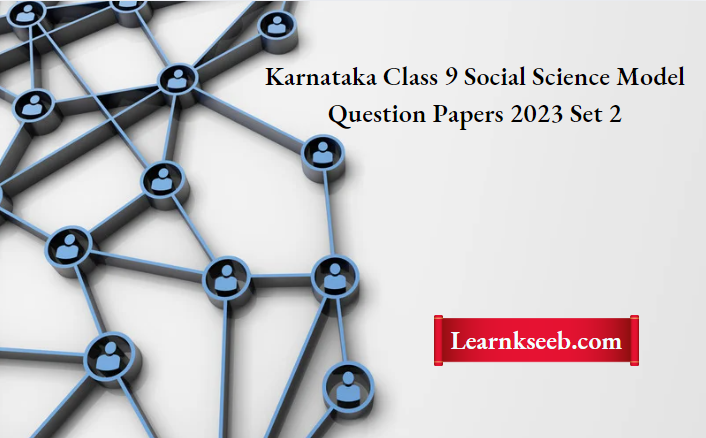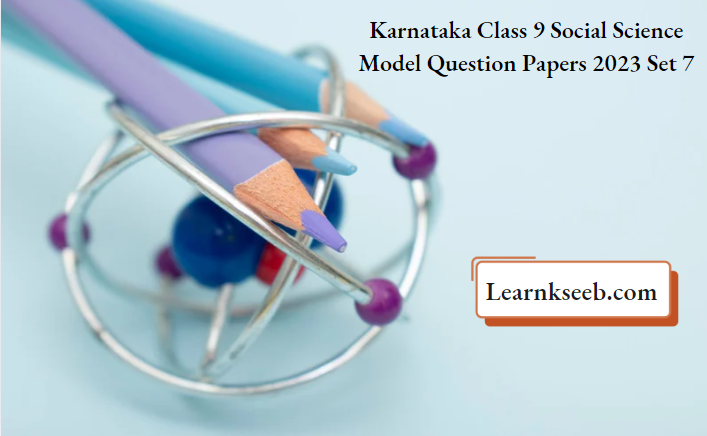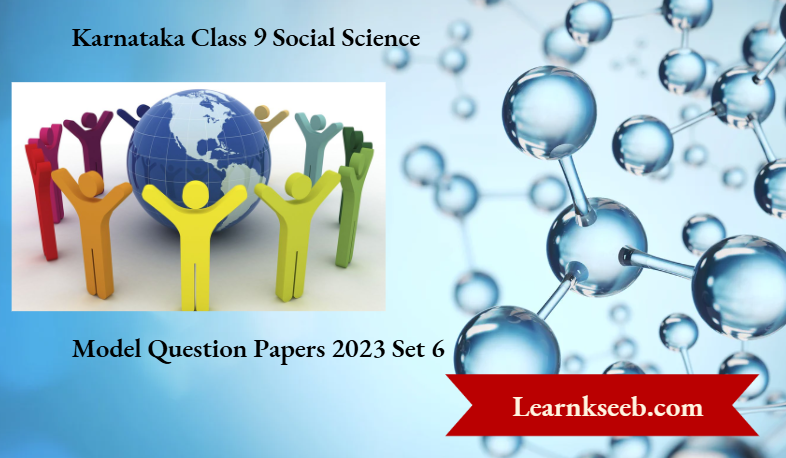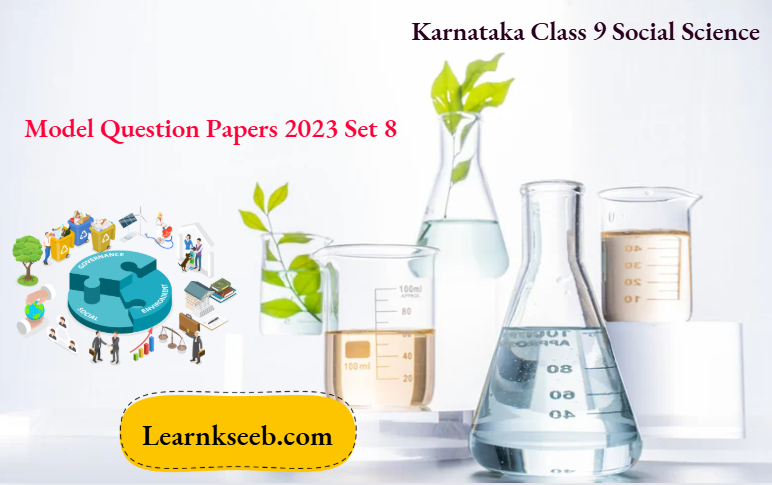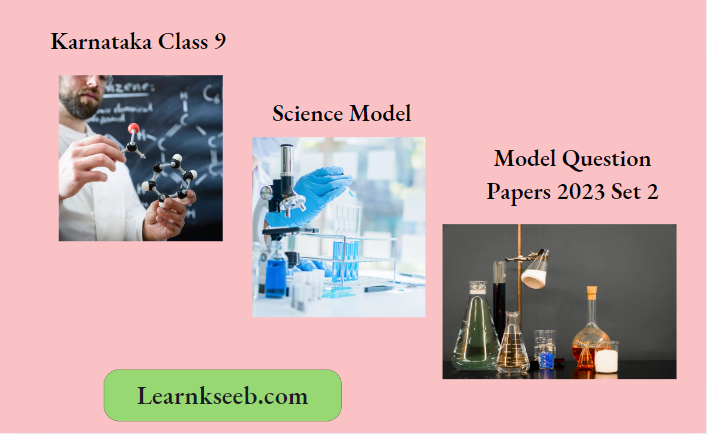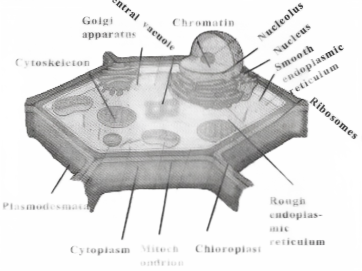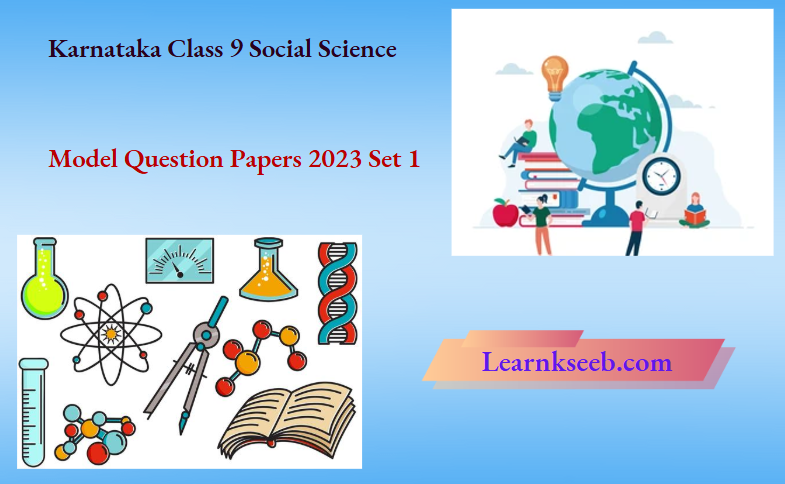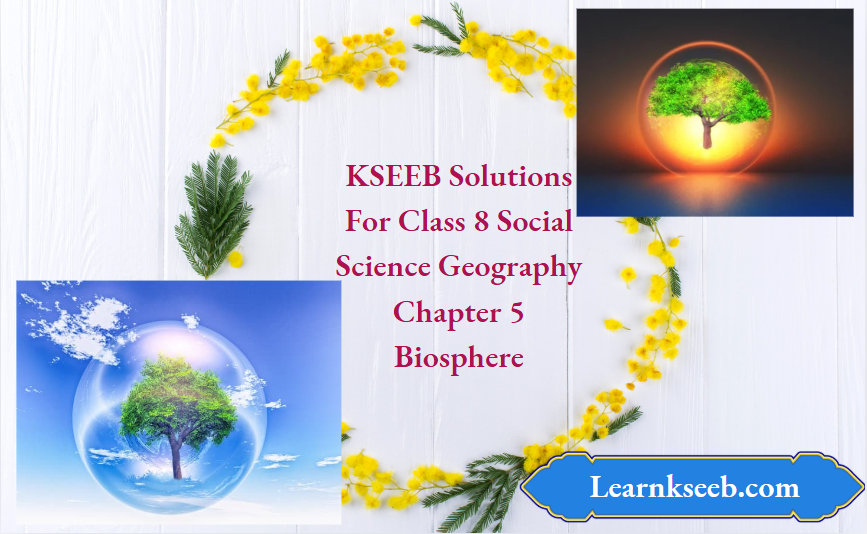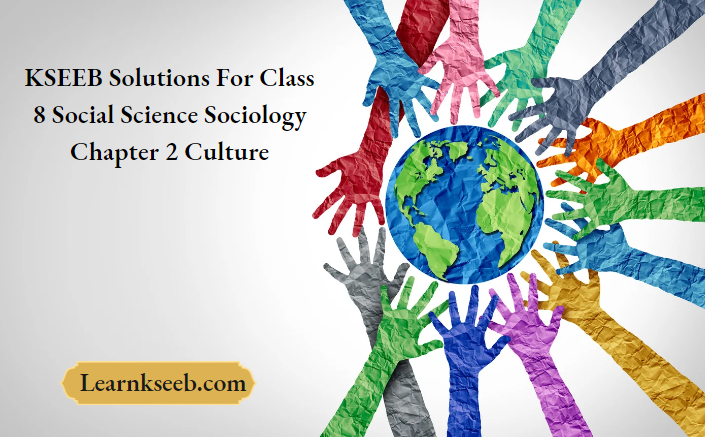Karnataka Class 9 Social Science Model Question Papers 2023 Set 5
Choose the correct alternative and Write the complete answer along with its alphabet in the sheet provided:
Question 1. Hijra refers to
- Journey of Prophet Mohammed from Mecca to Medina
- Birth of Prophet Mohammed at Mecca
- Marriage of Prophet Mohammed and Khadija
- Birth of Fathima
Answer: 1. Journey of Prophet Mohammed from Mecca to Medina
Question 2. The leader of the Counter-Reformation was
- Martin Luther
- John Wycliffe
- Ignatius Loyola
- Petrarch
Answer: 3. Ignatius Loyola
Question 3. The success or failure of the State Government depends on the personal charm of the
- Governor
- Prime Minister
- Chief Minister
- President
Answer: 3. Chief Minister
Question 4. The chairman of the Rajya Sabha is the
- Speaker
- Prime Minister
- Vice President
- President
Answer: 3. Vice President
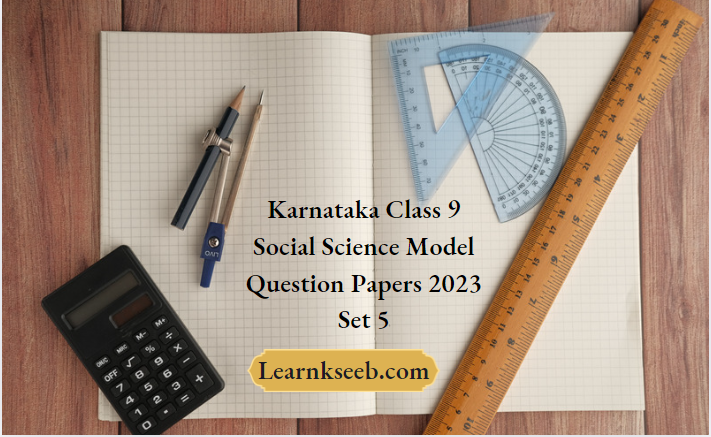
Question 5. The Living Cell of the Society is
- Family
- Village
- Town
- State
Answer: 1. Family
Question 6. The first air travel facility began between Bengaluru and Hyderabad by
- Sahara Airways
- Kingfisher Airways
- Deccan Airways
- Indian Airways
Answer: 3. Deccan Airways
Class 9 Social Science Model Papers Karnataka Set 5
Question 7. Karnataka state has won the award for the best tourist state as it
- Home to many tourist places
- Has the best tourism management
- Encourages private companies for tourism development
- Was the first state to start a tourism department
Answer: 2. Has the best tourism management
Question 8. The program introduced to construct toilets is
- Prime Minister’s Gramodaya Yojana
- Yashaswini Yojana
- Sandhya Suraksha Yojana
- Nirmal Gram programme
Answer: 4. Nirmal Gram program
Question 9. The first share market in India was started in
- Bombay
- Madras
- Kolkata
- Delhi
Answer: Bombay
Question 10. The first share market in the World was started in
- Bombay
- London
- New York
- Berlin
Answer: 2. London
Fill in the blanks:
- The head of the Revenue Tax Board is the Revenue Secretary •
- The headquarters of the Defence Ministry is in New Delhi.
- A group of clans with kinship is called Tribe
- The district which has the smallest urban population is Kodagu district.
- As economic development takes place, the share of workers in the agriculture sector declines.
Match the following
A B
Jayadeva Chand Bardahi
Bharthruhari Bhoja Prabandha
Mahendrapala Prithiviraja Vijaya
Jayanika Geethagovinda
Hemachandra Ravana Vadha
Kavya Meemamse
Kumarapla Charitha
Answer:
A B
Jayadeva Geethagovinda
Bharthruhari Ravana Vadha
Mahendrapala Kavya Meemamse
Jayanika Prithiviraja Vijaya
Hemachandra Kumarapla Charitha
Answer the following
Question 1. Who were the parents of Basaveshwara?
Answer: Basaveshwara was the son of Madarasa and Madalambika of Basavanabagewadi in Vijayapura district.
Question 2. Who are Sikhs?
Answer: Both Hindu and Muslim followers of Guru Nanak are called ‘Sikhs’.
Question 3. How did Sher Shah earn the title “Sultan of the fair justice”?
Answer: Sher Shah was known for his impartial justice. Hence he earned the title “Sultan of fair justice”.
Question 4. Why is Lok Adalat established?
Answer: Government has set up other forms of legal institutions which function faster and are less expensive.
Question 5. Which are factors posing threats to national unity?
Answer: Parochialism and regionalism are posing threats to national unity.
2023 Karnataka Social Science Model Papers Class 9 Set 5
Question 6. What are the lessons learned by a child at home?
Answer: The child learns their first lesson in love, affection, trust, patience, kindness, cooperation, and other values at home.
Question 7. What is social change?
Answer: Social change can be defined as the transformation that took place in the lifestyle of common people.
Question 8. Which are the by-products of Sugar cane?
Answer: Bagasse and molasses are the by-products of the sugar industry.
Question 9. What is dry farming?
Answer: The cultivation of crops that depend on rain is called dry farming.
Question 10. What is irrigation?
Answer: The cultivation of crops that depend on rain is called dry farming.
Question 11. What is the density of the population?
Answer: The number of people living in an area of one square kilometer is known as the density of the population.
Question 12. Give the meaning of poverty.
Answer: The condition in which people are deprived of their fundamental needs like food, clothing, shelter education, and health is called poverty.
Question 13. What are the basic requirements of a human being?
Answer: The basic requirements of a human being are food, clothing, shelter education, and health.
Question 14. What is profit according to W.C.F. Heartly?
Answer: Profit to the business is like food to the body (W.C.F. Heartly).
Answer The Following
Question 1. Explain the Advaita philosophy
Answer: The world is Maya, an illusion; Brahma is the absolute truth. People are ignorant; they are not aware of the illusionary nature of the world. They are also not aware that Brahma is the only Truth, Hence we should go on the path of knowledge, and realize the nature of the world. Ultimately, we should merge our ‘Atma’ (soul) with the absolute truth, Brahma. Only then we can attain moksha (liberation). In this manner, Shankaracharya taught the path of knowledge.
Question 2. Give reasons for the downfall of the feudal system.
Answer:
The reasons for the downfall of the feudal system are:
- The rise of powerful dynastic rule in England, France, and Spain
- Development of regional languages
- Development of nationalism
- Lust for absolute power among the kings
- Military power
- The Crusades hastened the fall of many systems
- The Renaissance and Reformation
Question 3. The American War of Independence created a new era in Europe. Justify.
Answer:
- The war acted as an inspiration for the French Revolution.
- Many of the Spanish and Portuguese colonies in America got inspired to become free and hence, revolted against their motherland.
Question 4. Explain the role of Mazzini in Italian Unification.
Answer: Mazzini was a noted revolutionary thinker and writer. He provoked the youth of Italy through his writings in the book Italy, Austria, Papacy. He inspired people with feelings of national integration, freedom, and rebellious thoughts and provoked them to revolt. He not only built an army called young Italy but also had the aim of achieving national freedom and integration.
Karnataka Class 9 Social Science Exam Practice Papers Set 5
Question 5. Why was the Right to Information Act passed?
Answer:
The objectives of the Right to Information Act are:
- To check corruption in public life,
- To bring transparency in administration and
- To make the government accountable to the people.
- To empower the people to get information from the government bodies by filling out an application.
- To provide the information sought, within 3 0 days.
- To provide life and liberty-related information within 48 hours.
Question 6. Which are the factors that promote national integration?
Answer:
The factors that promote national integration are:
- Secularism
- Democracy
- National Festivals
- Our National Symbols
- Interdependence
- Communication methods
- Mass media
- Natural features
Question 7. Explain the role of mass media in the socialization process.
Answer:
The role of mass media in the socialization process is
- The media make use of literature on a large scale
- Quotations from great men, proverbs, and words of wisdom influence children.
- The mass media can be used effectively through news reports, quiz programs, etc
- Programs of educational importance have a direct bearing on the personality and good conduct of the child.
- The adolescent and the youth are moving away from values and culture.
Question 8. Give the latitudinal and longitudinal extent of Karnataka.
Answer: It extends from 11°-311 North to ISMS1 North latitude and 74°-12r East to 78°-40 East longitude.
Question 9. Name the main hills of Southern maidan.
Answer: The main hills of Southern maidan are Chitradurga hills, Narayana Durga, Savanadurga, and Shivaganga in Bengaluru rural district, Madhugiri hill in Tumakuru district is the biggest ‘monolith hill’ in Asia, Nandi hills, Chennakeshava hill, Kavaledurga and Skandagiri hill (Harihareswara hill) in Chikkaballapura district, Adichunchanagiri hills in Mandya district, Biligirirangana hill, Malemadeswara hill, Hamid Gopala Swamy hills in Chamarajanagar district, Chamundi hill in Mysuru district are prominent.
Question 10. What is Irrigation? Why is it necessary?
Answer: The artificial supply of water for agriculture is called irrigation. It is essential for the development of agriculture in places where the distribution of rainfall is uneven and irregular.
Class 9 Karnataka Social Science Model Papers Set 5 PDF
Question 11. What factors are essential to start the sugar industry?
Answer:
- The sugar industry in Karnataka is concentrated in sugar-growing areas.
- It is an annual crop and is growing in irrigated areas.
- This crop needs high temperatures and moisture.
- With temperatures of 21° to 26° Celsius and 100- 150 cms annual rainfall.
- Fertile loamy soil mixed with black soil is most suitable.
Question 12. Why is the demand for gold increasing?
Answer: Gold is a very rare, glittering, and durable yellow metal. It is used for making ornaments, and in the manufacture of valuable articles like watches, etc.
Question 13. Name the important waterfalls of Karnataka.
Answer:
The important waterfalls of Karnataka are:
- Jog Falls – Shivamogga
- Gaganachukki and Bharachukki – Mandya
- Abbe falls – Mercara
- Hebbe falls – Kemmanagundi ( Chikka Magaluru)
- Kalhatagiri falls and Unchalli Falls – Uttara Kannada
- Gokak Falls- Belagavi
Question 14. Which are the important employment programs adopted in Urban areas of India?
Answer:
The important employment programs adopted in Urban areas of India are:
- 1989-Nehru Rozgar Yojana (NRY)
- 1990-Scheme of Urban wage Employment (SUWE)
- 1993 –Prime Minister Rozgar Yojana (PMRY)
- 1997 –Swarna Jayanti Shahari Rojgar Yojana (SJSRY)
Karnataka 9th Social Science Model Papers Set 5 with Answers
Answer the following
Question 1. Explain the contributions of the Delhi Sultans to art and architecture.
Answer:
- The Delhi Sultans introduced a new style of architecture known as ‘Indo-Islamic’ architecture.
- Arches, domes, and minarets are the main features of this style.
- The Delhi Sultans built forts, Mosques, palaces, public buildings, madrasas, and Dharamshala.
- Qutub Minar, Quvat-Ul-Islam mosque, Allai Dharavaja, and Kuwait Khana mosque are a few examples of Indo-Islamic style. (OR)
Question 1. Explain the characteristics of the Sher-Shah administration.
Answer: Sher shah gave importance to strengthening the administrative structure. He was the ultimate head f administration and ran the administration with the help of the council of ministers. Both the civil and military powers were in the hands of the king. The entire kingdom was divided into sarkar (regions) and paragons. Cavalary, infantry, and elephant divisions were there in the army. Among these, cavalry was powerful. In order to bring discipline among the soldiers, he started ‘attendance’ for soldiers and ‘stamping (Daag) for horses. The army was divided into small units called four with a head founder. Sher shah took a personal interest in organizing and supervising the army.
Question 2. Which are the Fundamental Rights incorporated in our Constitution?
Answer:
The Fundamental Rights incorporated in our Constitution are:
- Right to Equality (Article 14th to 181,1)
- Right to freedom (Article 19th to 22nd)
- Right against Exploitation (Article 23rd to24th)
- Right to freedom of Religion (Articles 25 to 28th)
- Cultural and Educational rights (Articles 29 to 30th)
- Right to Constitutional Remedies (Article 32nd) (OR)
Question 2. What are the qualifications required for a Legislative Assembly member?
Answer:
Qualifications for a Legislative Assembly member are:
- Should be a citizen of India.
- Should have completed 25 years of age.
- Should not be employed in any office of profit of the Government.
- Should not have been punished by any court.
- Should not be of unsound mind. 6. Should not be insolvent.
- Should possess the qualifications as decided by the Parliament from time to time.
Question 3. How does the family teach social behavior to its members?
Answer: Family plays a very important role in the socialization process of a child. Father-mother is direct blood relatives of the child. The idiom ‘Mother is the first teacher of the child’ is literally true. The behavior, custom, practices, activities, the interaction of father and mother will extremely influence the emotional development of the child. The child learns the first lesson of life values such as love, concern, faith, patience, cooperation, coordination, etc, at home itself. The appreciation from the family always encourages the activities of the child. Children are obedient to their parents because they are old enough in their age, experience, and authority. Due to the socialization process, the hearts of the children blossom, and family is the basic foundation for all these processes (OR)
Question 3. Explain the types of the rural community.
Answer:
There are different types of rural communities. They are:
- Centralized villages:- Houses are located in the form of land.
- Villages of bifurcated houses and farmland:- They are found in the coastal region and in irrigated areas of the Raichur district of Karnataka.
- Scattered group villages:- Villages are located in hilly areas and in uplands districts of Karnataka.
- Village of line houses:- Families are located on the both sides of the road.
- Moon-shaped villages:- The village is surrounded by a temple masjid, church tank, etc.
- Square-shaped villages:- Villages are the same as line villages. Lines are parallel
- Joint road and market village:- Houses are located where two or more roads join together,
Practice Papers for Karnataka Class 9 Social Science Set 5
Question 4. Name the climatic seasons of Karnataka with their period.
Answer:
We can classify the climate of Karnataka over a period of one year, as can be done with the climate of India, into four parts:
- The summer season (March to May)
- The rainy season (June to September)
- The period of Retreating Monsoons (October – November)
- The winter season (December – February) (OR)
Question 4. Name the different types of agriculture practiced in Karnataka.
Answer: They are subsistence farming, irrigation farming, dry farming, mixed farming, shifting cultivation, commercial farming, plantation farming, etc
Question 5. What measures will you take to reduce the ecological footprint?
Answer:
The measures taken to reduce the ecological footprint are:
- Conservation of food
- Conservation of energy/ Electricity
- Judicial utilization of the Transport system
- Creating less waste
- Conservation of water
- Educating community regarding ecological footprint. (OR)
Question 5. What measures are taken to improve the quality of the population?
Answer:
The measures taken to improve the quality of the population are:
- Providing better education
- Providing better health facilities
- Providing training
- Encouraging new research
Karnataka Board Class 9 Social Science Solved Papers Set 5
Question 6. Explain in brief the part played by the stock exchange in financial matters of business.
Answer:
The part played by the stock exchange in financial matters of business is:
- Stock Exchange is one of the constituents of the capital market.
- The Stock exchanges regulate and control businesses in buying, selling, and dealing in securities.
- They are regulated by the government.
- They do not engage only in the purchase and sale of securities but provide a place where members can carry out their business on their own account under codes, rules, and regulations. (OR)
Question 6. What are the functional areas of management?
Answer:
Managerial functions may be classified into different areas. Some of them are :
- Planning
- Organizing
- Staffing
- Directing
- Coordinating
- Controlling.
Answer the following
Question 1. Describe the administration and revenue system of the Bahamani sultans.
Answer:
- Administration: There were three levels of administration namely Central, Provincial, and Village. Among these, there was revenue, judicial and military administration too. The Sultan was the chief of the central administration. The cabinet was called Majlis-E-Ilwith. Top officials, commandants, ulemas, and admins were friends and relatives of the Sultan. Gawan converted the then existed four ‘Tarafs ’ (provinces) into eight units and these provinces were divided into fifteen Sarakars, The Subedar was the administrator in each of these Sarkars. Sarakars were divided into paraganas. Kotwal, Deshmukh and Desai were the administrators of the paraganas.
- Revenue system: Amir-E-Jumlas was the head of the revenue authorities. Land tax was the main source of income for the kingdom. 1/2 to 1/4 of the agricultural production was collected as land tax. There were 50 kinds of taxes including taxes on the house, mines, tobacco, grasslands, trade, and employment. The money earned by taxation was used for maintaining palaces, war and bodyguards, construction and ‘ maintenance of forts.

